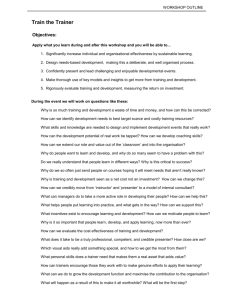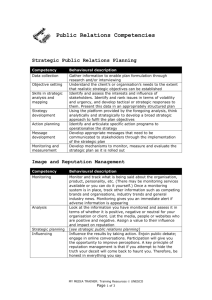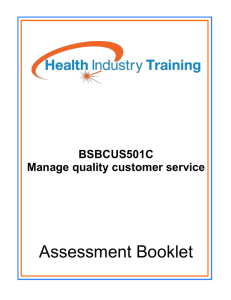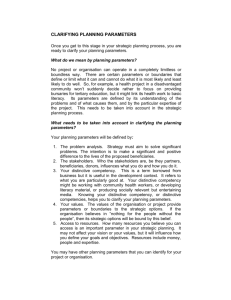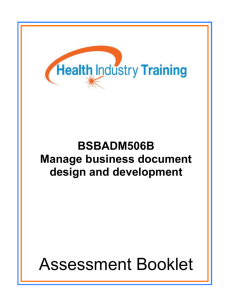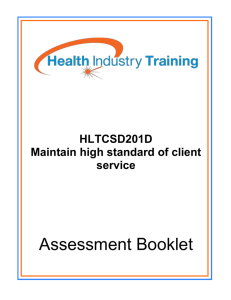BSBFLM309C Support continuous improvement systems and
advertisement
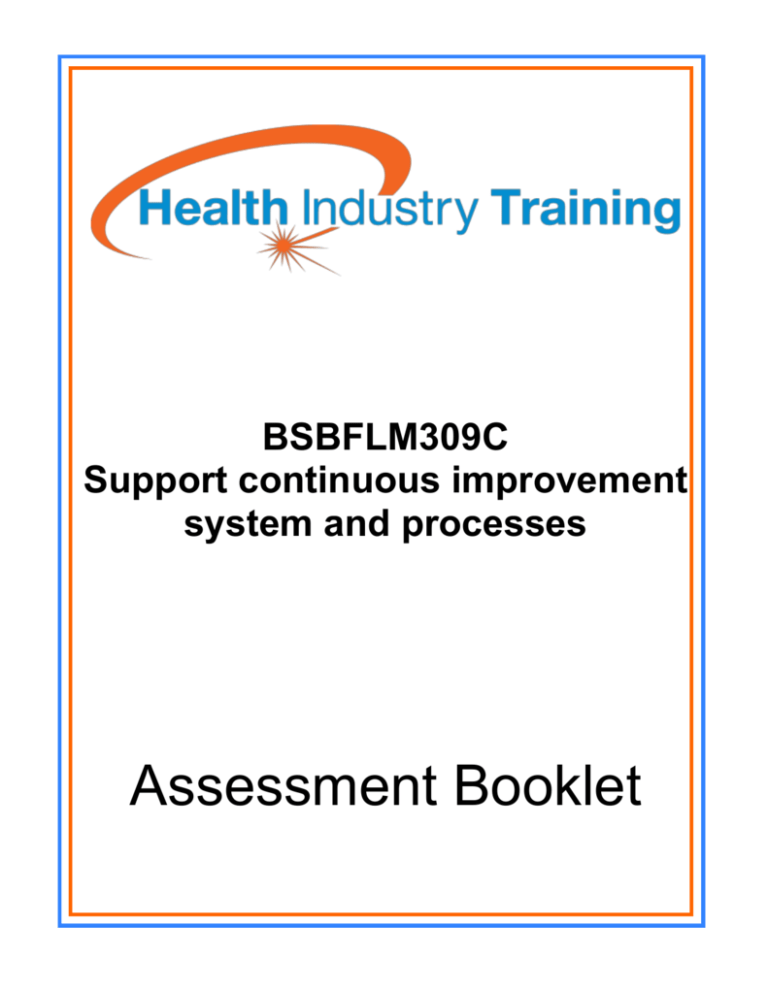
BSBFLM309C Support continuous improvement system and processes Assessment Booklet © Copyright 2011 GP Links Wide Bay trading as Health Industry Training PO Box 702 HERVEY BAY 4655 Version 2: August 2012 ASSESSMENT COVER SHEET Unit Code: BSBFLM309C Unit Title: Support continuous improvement systems and processes Trainer Comments: ________________________________________________________________________________________ ________________________________________________________________________________________ ________________________________________________________________________________________ ________________________________________________________________________________________ ________________________________________________________________________________________ ________________________________________________________________________________________ ________________________________________________________________________________________ Student Name: ___________________________________________ Student No.: ___________________ Date Due: _____ / _____ / _____ Date Submitted: _____ / _____ / _____ Student Declaration: I declare that I understand how assessment will take place for this unit. I also understand that work completed towards this assessment must be verifiably my own. __________________________________ _____________________________________ ______________ Student Name Student signature Date Trainer Sign-off: I declare the above named student was assessed by me for the above mentioned unit __________________________________ _____________________________________ ______________ Trainer Name Trainer signature Date BSBFLM309C Support continuous improvement systems and processes Assessment tool ASSESSMENT INFORMATION Information to competency assessment To be assessed as competent, you must, under the guidance of qualified trainers and assessors provide evidence which demonstrates that you can perform to the necessary standard. An assessment of competence requires learners to consistently and over time demonstrate the skills, attitude and knowledge that enable confident completion of work tasks in a variety of situations. In judging evidence, the trainer must ensure that the evidence is: Authentic (the candidate’s own work) Valid (directly related to the current version of the relevant endorsed unit of competency) Reliable (shows that the candidate consistently meets the endorsed unit of competency) Current (reflects the candidate’s current capacity to perform the aspects of the work covered by the endorsed unit of competency). and Sufficient (covers the full range of elements in the relevant unit of competency and address the four dimensions of competency, namely; task stills, task management skills, contingency management skills, and job/role environment skills). Access and equity An individual’s access to the assessment process should not be adversely affected by restrictions placed on the location or context of assessment beyond the requirements specified in the training package. Reasonable adjustments can be made to ensure equity in assessment for people with disabilities. Adjustments include any changes to the assessment process or context that meet the individual needs of the person with a disability, but do not change competency outcomes. Such adjustments are considered reasonable if they do not impose an unjustifiable hardship on a training provider or employer. When assessing people with disabilities, trainers are encouraged to apply good practice assessment methods with sensitivity and flexibility. Trainers should also provide alternative assessment activities to address identified specific organisation requirements. The assessment process must: Provide for valid, reliable, flexible and fair assessment Provide for judgement to be made on the basis of sufficient evidence Offer valid, authentic and current evidence Include workplace requirements as suggested in the range of variables Health Industry Training Page 1 BSBFLM309C Support continuous improvement systems and processes Assessment tool UNIT INFORMATION Unit code BSBFLM309C Unit title Support continuous improvement systems and processes Unit descriptor This unit specifies the outcomes required to support the organisation's continuous improvement systems and processes. Particular emphasis is on actively encouraging the team to participate in the process, on monitoring and reporting on specified outcomes and on supporting opportunities for further improvements. No licensing, legislative, regulatory or certification requirements apply to this unit at the time of endorsement. Employability skills This unit contains employability skills including communication, teamwork, problem solving, initiative and enterprise, planning and organising, self management, learning and technology Application of the unit This unit replaces BSBFLM309A Support continuous improvement systems and processes. Frontline managers have an active role in supporting continuous improvement processes in achieving the organisation's objectives. Their position closely associated with the creation and delivery of products and services, means that they have an important responsibility in influencing the ongoing development of the organisation. At this level, work will normally be carried out within known routines, methods and procedures, and may also involve a number of complex or non-routine activities that require some discretion and judgement. Unit sector or competency field None specified Pre-requisite, co-requisite or interdependent assessment of units None specified Context of and specific resources for assessment Assessment must ensure: Method of assessment Health Industry Training access by the learner and trainer to appropriate documentation and resources normally used in the workplace that this unit is assessed in the workplace or in a closely simulated work environment Assessment may include observation, questioning and evidence gathered from the workplace or simulated environment Page 2 BSBFLM309C Support continuous improvement systems and processes Assessment tool Critical aspects for assessment Evidence of the following is essential: Examples of actions taken by the candidate to support continuous improvement including: use of work performance to identify improvement adjusted plans to reflect changes effective communication to all stakeholders use of technology to monitor operational progress application of suitable recordkeeping processes Required skills and knowledge Required knowledge: Legislation from all levels of government that affects business operation, especially in regard to occupational health and safety and environmental issues, equal opportunity, industrial relations and anti-discrimination principles and techniques of: • continuous improvement systems and processes • benchmarking • best practice Benefits of continuous improvement Quality approaches which the organisation may implement Methods that can be used in continuous improvement Barriers to continuous improvement Recording, reporting and recommendation processes to facilitate continuous Improvement applied within the organisation Required skills: Health Industry Training Ability to relate to people from a range of social, cultural and ethnic backgrounds and physical and mental abilities Functional literacy skills to access and use workplace information Research, analysis, interpretation and reporting skills Monitoring and evaluation skills Communication skills to: • gain the commitment of individuals and teams to continuous improvement • deal with people openly and fairly • use consultation skills effectively Skills to consolidate opportunities for improvement Coaching and mentoring skills to provide support to colleagues Page 3 BSBFLM309C Support continuous improvement systems and processes Assessment tool Element Performance Criteria 1. Contribute to continuous improvement systems and processes 1.1 Actively encourage and support team members to participate are in decision making processes and to assume responsibility and exercise initiative 1.2 Communicate the organisation's continuous improvement processes to individuals and teams 1.3 Effectively utilise mentoring and coaching to ensure that individuals/teams are able to support the organisation's continuous improvement processes 2.1 Utilise the organisation's systems and technology to monitor team progress and to identify ways in which planning and operations could be improved Apply continuous improvement techniques and processes to improve customer service 2. Monitor and report on specified outcomes 2.2 3. Support opportunities for further improvement Health Industry Training 3.1 Communicate agreed recommendations for improvements in achieving the business plan to team members 3.2 Document and use work performance to identify opportunities for further improvement 3.3 Maintain records, reports and recommendations for improvement within the organisation's systems and processes Page 4 BSBFLM309C Support continuous improvement systems and processes Assessment tool ASSESSMENT TOOLS Assessment is conducted throughout the course using different assessment tools including written/oral assessment, projects, practical demonstrations, case studies and role plays and observation. Both skills and knowledge are assessed in line with the requirements of the Australian Quality Training Framework (AQTF) and the training package. Recognition of Prior Learning Recognition of Prior Learning (RPL) is a formal recognition of your current skills and knowledge you have achieved outside the education and training system. RPL takes into account any previous formal study, work and life experience and then assesses this against the elements of competency to determine if you can receive credit toward a qualification. Students seeking recognition can apply by contacting the Manager Health Industry Training at the commencement of study. Credit Transfer Students who have completed a formal unit within their intended qualification with another Registered Training Organisation (RTO) may be able to apply for a credit transfer or exemption. A certified copy of the original documentation must be provided when applying for a credit transfer. Written/oral questions assessment tool Written/oral questions are designed to enable assessment of the required knowledge. Where appropriate they may also enable assessment of elements and performance criteria. As with activities responses might be drawn from: The theory/information contained in this resource Additional reading and research Supplementary materials provided by the trainer/assessor Trainers/assessors might develop additional questions to elicit more detailed responses. Alternative questioning methods might also be used where access and equity issues need to be considered. Project(s) assessment tool Project(s) are designed to enable holistic assessment of the unit of competency if possible. The trainer/assessor should consider each project in the context of the specific industry sector and/or organization and make adjustments or contextualize as necessary. Access and equity issues should also be considered. Additional projects may also be required. Other assessment activities Other assessment activities determined by the trainer could include a range of assessment tools appropriate for this unit to demonstrate competencies which sufficiently address: The relevant performance criteria Critical aspects for assessment The required skills and knowledge The context and consistency of the assessment requirements The relevant employability skills Health Industry Training Page 5 BSBFLM309C Support continuous improvement systems and processes Assessment tool To assist with demonstration of competencies and in conjunction with the assessment for this unit, the trainer may implement additional assessments in the form of: practical demonstrations case studies role plays observation Trainers/assessors should ensure that the learner fully understands the assessment process and the assessment tasks that need to be undertaken. A copy of the assessment tool must be placed on the student record as proof of evidence. ASESSMENT INSTRUCTIONS Assessment format and layout All assessments must be: Typed in Arial 12, single spacing with headings in bold Header and Footer to be inserted in each page. Header to include unit code and title. Footer to include student name and page number All work must be referenced throughout the assessment. Referencing should include author and year of publication and website address (if applicable). There are many referencing guides available on the Internet to assist students. Plagiarism Plagiarism is the act of representing as one's own original work the creative works of another, without appropriate acknowledgment of the author or source. In all written work submitted for assessment you must show the sources for your material. The principle is that whenever submitted material is not your own original work this must be referenced to acknowledge the author’s work. It is expected that when a student submits an assessment that it is the independent work of that student and they have written it in their own words. If a student has plagiarised another person’s work they will be asked to resubmit their assessment. Plagiarism can lead to instant dismissal. Submission All assessments must be submitted in the format described. A date for submission will be set by the trainer. Assessments must be submitted on or before this date or an extension must be granted by the trainer. The assessment cover sheets must be detached from the assessment booklets and attached to the front of each assessment. All sections of the cover sheet must be completed by the student prior to submission of assessment. The bottom section of the assessment cover sheet will be retained by the trainer. Resubmitting assessments If a student is marked ‘not competent’ they will be provided with an alternative assessment for completion to be able to demonstrate competency. An assessment resubmission should be treated as the original assessment with all principles applying. Health Industry Training Page 6 BSBFLM309C Support continuous improvement systems and processes Assessment tool ASSESSMENT – BSBFLM309C Support continuous improvement systems and processes In your own words, answer the following questions. To be marked as competent in this unit, you must provide sufficient responses to each question. Bullet points must only be used where applicable eg: if the question asks you to list, name or give examples. 1. There are a number of key provisions of relevant legislation and regulations from all levels of government that that may affect aspects of business operations, such as: a) b) c) d) e) f) g) h) Anti-discrimination legislation. Ethical principles. Codes of practice. Privacy laws. Financial legislation. Occupational health and safety (OHS) legislation. Consumer law. Credit procedures legislation and regulations. Why is it necessary to have a working knowledge of the legislation involved in business? What is the aim of OHS legislation and what responsibilities does it place on employers? 2. Whilst continuous improvement processes are beneficial to organisations, there are a number of barriers to its implementation. What are 10 barriers to continuous improvement? 3. What are the quality approaches known as 'continuos improvement', 'benchmarking' and 'best practice'? Where does information on best practice come from? What areas might benchmarking performance criteria be created for? 4. What are the benefits of continuous improvement? 5. In the cyclical approach to quality improvement it is essential that records, reports and recommendations pertaining to improvement are documented. Why? What are the benefits if documentation? How can the information in these documents be communicated effectively? 6. What should you do when making recommendations for change? 7. When attempting to use continuous improvement processes to improve customer service levels, what methods could you use to gather information about what improvements need to be made? Health Industry Training Page 7 BSBFLM309C Support continuous improvement systems and processes Assessment tool ASSESSMENT – BSBFLM309C Support continuous improvement systems and processes In your own words, answer the following questions. To be marked as competent in this unit, you must provide sufficient responses to each question. Bullet points must only be used where applicable eg: if the question asks you to list, name or give examples. Questions 1. There are a number of key provisions of relevant legislation and regulations from all levels of government that that may affect aspects of business operations, such as: a. b. c. d. e. f. g. h. Anti-discrimination legislation. Ethical principles. Codes of practice. Privacy laws. Financial legislation. Occupational health and safety (OHS) legislation. Consumer law. Credit procedures legislation and regulations. Why is it necessary to have a working knowledge of the legislation involved in business? What is the aim of OHS legislation and what responsibilities does it place on employers? 1. Whilst continuous improvement processes are beneficial to organisations, there are a number of barriers to its implementation. What are 10 barriers to continuous improvement? 2. What are the quality approaches known as 'continuous improvement', 'benchmarking' and 'best practice'? Where does information on best practice come from? What areas might benchmarking performance criteria be created for? 3. What are the benefits of continuous improvement? 4. In the cyclical approach to quality improvement it is essential that records, reports and recommendations pertaining to improvement are documented. Why? What are the benefits if documentation? How can the information in these documents be communicated effectively? 5. What should you do when making recommendations for change? 6. When attempting to use continuous improvement processes to improve customer service levels, what methods could you use to gather information about what improvements need to be made? To be marked competent in this unit, students must respond to all points in the project. Answers must be comprehensive, detailed, demonstrate appropriate research procedures and be supported by suitable references. Project Choose a process within organisation with which you are familiar, to complete this project. Alternately you may complete it hypothetically. You are to identify and report on a process that needs to be, or can be improved. This could be an already identified problem area, or an area where you consider changes can improve productivity and effectiveness, pre-empting future problems. Health Industry Training Page 8 BSBFLM309C Support continuous improvement systems and processes Assessment tool Write a report on the process and its improvement by following the structure below: Background information Briefly describe the organisation and its core business. If the process you have selected occurs in part of the organisation describe that section more fully. Describe the process in its current form. Present this information in a flow chart if this is helpful. Describe the problem with the process. Data gathering plan Discuss the tools that you will use to gather data about the process and why you chose these tools. Discuss how you will analyse the data. Improvement plan From the data that you gathered, identify possible improvements and write them as recommendations. Set targets for those improvements. Apply continuous improvement techniques Discuss the techniques and processes you will use to implement your recommendations to improve customer service in your focus area. Communication and support plan Explain how you will: Communicate the targets for improvements to your team members Communicate the intended continuous improvement processes Encourage and support team members Utilise training, mentoring and coaching Monitoring and record keeping plan Explain how you will monitor team progress against the targets. Discuss how you will know if your continuous improvement strategy was successful. List the records you will need to maintain. Health Industry Training Page 9
